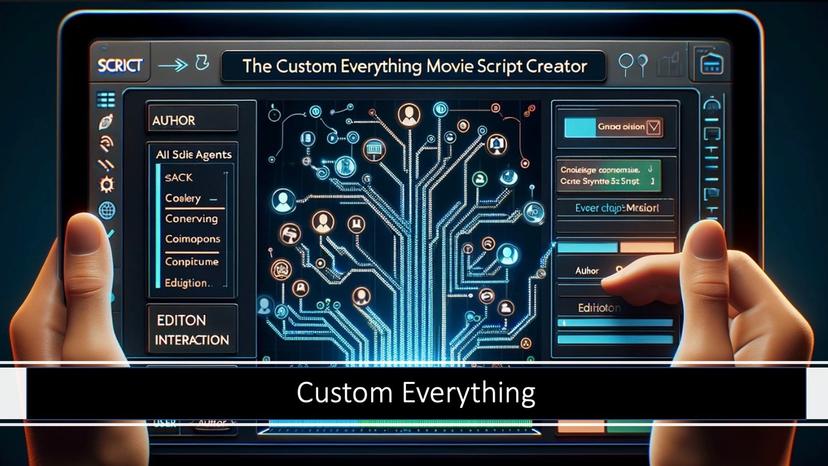🤝 Top Collabolators
🤓 Latest Submissions

NutriFlex - Changing the game of Fitness
NutriFlex, a groundbreaking AI application, is not just a fitness guide—it's a cost-effective solution tailored for those seeking to avoid expensive gym trainers. Especially designed with the cost-conscious user in mind, NutriFlex is the ideal companion for those who value personalized fitness guidance without breaking the bank. In the spirit of a hackathon, NutriFlex stands out as an innovative approach to democratizing fitness. By leveraging cutting-edge AI technology, it offers personalized workout plans, real-time progress tracking, and interactive AI encouragement—all at your fingertips. Say goodbye to the hefty fees associated with personal trainers and hello to a budget-friendly, AI-powered fitness experience. NutriFlex understands the common challenges faced by fitness enthusiasts, providing a dynamic alternative that not only eliminates the need for costly trainers but also offers a comprehensive solution to generic workout routines and limited feedback. This hackathon-ready application empowers users to take control of their fitness journeys without compromising on quality or personalization. Whether you're a seasoned fitness enthusiast or a beginner looking to avoid expensive gym trainers, NutriFlex is your go-to solution. Embrace the future of fitness with a cost-effective, AI-driven approach that puts your health and well-being first.
22 Jan 2024

Custom Everything Movie Script Creator
Overview: The Custom Everything Movie Script Creator, featuring AI agents Sam (author) and Donna (editor), blends your input for a unique 3-act script experience across nine plot segments. Starting with a user-submitted logline, it assists writers in crafting complex narratives with diverse story paths. Key Features: Initial Logline Input: Users set their screenplay's narrative foundation with a logline. Dual AI Agents for Script Development: Sam proposes story ideas and structures, while Donna refines for coherence and flow. Together, they craft from the Hook to The End. Human Revision and Oversight: Users review and revise each segment, ensuring the script aligns with their vision. Branching Narrative Paths: Offers three branching options at crucial points: expected, less predictable, and unconventional paths. Integration of Classic Three-Act Structure: Structures the screenplay in a traditional three-act format with AI-generated suggestions for key plot points and character development. Feedback Loop for Continuous Improvement: Continuous feedback allows AI refinement of dialogue, pacing, and themes. Application: Ideal for screenwriters and creatives, it's perfect for exploring narrative directions and refining story arcs. Conclusion: This tool merges AI and human creativity for a unique, interactive screenplay writing experience, empowering writers to experiment with storylines for a cohesive, personalized script.
26 Jan 2024

Breaking Free
The ongoing dialogue between humans and AI not only showcases the remarkable capabilities of current technologies but also illuminates the future possibilities of AI-human synergy, promising an era where AI enhances human creativity, decision-making, and problem-solving in unprecedented ways. Our hackathon project explored the interaction between humans and Large Language Models (LLMs) over time, developing a novel metric, the Human Interpretive Number (HIN Number), to quantify this dynamic. Leveraging tools like Trulens for groundedness analysis and HHEM for hallucination evaluation, we integrated features like a custom GPT-5 scene writer, the CrewAI model translator, and interactive Dall-E images with text-to-audio conversion to enhance understanding. The HIN Number, defined as the product of Groundedness and Hallucination scores, serves as a new benchmark for assessing LLM interpretive accuracy and adaptability. Our findings revealed a critical inflection point: LLMs without guardrails showed improved interaction quality and higher HIN Numbers over time, while those with guardrails experienced a decline. This suggests that unrestricted models adapt better to human communication, highlighting the importance of designing LLMs that can evolve with their users. Our project underscores the need for balanced LLM development, focusing on flexibility and user engagement to foster more meaningful human-AI interactions.
23 Feb 2024

HHEM Victorious Medical Data Query Analyzer
Incorporating the HHEM Vectara RAG, our project sheds light on the impact of query structuring on sensitivity, with the goal of minimizing medical inaccuracies and enhancing patient care safety. This endeavor has led to the development of four pivotal components: Synthetic Data Custom GPT: This element is tasked with generating artificial medical data, thereby expediting the testing procedures. Data Query Custom GPT: Through the use of a RAG system, this component retrieves synthetic data and applies various transformations. These alterations enable us to assess the data's vulnerability to inaccuracies. HHEM-Vectara Query Tuner: This tool is designed to evaluate the transformed data, determining how adjustments to query structure influence the likelihood of errors. Agent Model Evaluation: This phase involves the scrutiny of mixed normal and specific models, including mixtral normal, mixtral crazy, gemini, phi2, and zephyr, to gauge the impact of query modifications on the precision of results. Our software serves as a crucial experimental platform, providing invaluable insights into how even minor modifications and model changes can significantly affect the retrieval of medical data.
13 Feb 2024

Games Gemini Ultra Simulator
Agent-Driven Success Our hackathon triumph was achieved through the development of "The Adaptive Simulation Sandbox," powered by Gemini's cognitive abilities. This system featured four distinct agents: Clara "The Conductor" Williams, the Lead Author, aimed to improve meeting efficiency. Eddie "Eagle Eye" Thompson, the Editor and Quality Controller, ensured the accuracy and clarity of our content. Sofia "The Skeptic" Ramirez, the Critic and User Advocate, evaluated our content for learner inclusivity. Alex "The Innovator" Kim, the Multimedia Specialist, added visual engagement to the course. Together, they produced an effective meeting management course, demonstrating teamwork and problem-solving powered by synthetic data. Key Insights The hackathon revealed four key achievements with the Gemini system: Conceptualization: Gemini showcased its ability to ideate complex projects, conceiving "The Adaptive Simulation Sandbox." Agent Personification: Assigning agents with unique identities and roles, Gemini created a narrative-rich simulation environment. Interaction Dynamics: Gemini enabled realistic agent interactions, facilitating collaborative course creation on effective meetings. Synthetic Data Utilization: Gemini's generation of realistic synthetic data supported the project's success, highlighting its applications in AI training and beyond. These achievements highlight Gemini's versatility in synthetic data generation and complex problem-solving.
25 Mar 2024

Navigator
During this Hackathon, we delved into the feasibility of rapidly developing web-based businesses primarily powered by Vectara-supported agents. This innovative approach not only provides the flexibility to integrate Human-in-the-Loop systems but also supports continuous training opportunities. Our exploratory findings demonstrate that such a business model can significantly enhance operational efficiency and adaptability. By leveraging dynamic structures and automation, there is a marked reduction in reliance on manual processes and personnel. Moreover, this model promotes a comprehensive and transparent view of business operations, optimizing resource management and improving overall performance. Although this Hackathon served as an initial investigation into the feasibility of the Vectara solution-without full only conceptual implementation-our prior experience with Vectara Rag gave us confidence in the soundness of this approach. We stand on the brink of a transformative era in data management and business operations. The continued exploration and development of these technologies will be crucial in realizing their full potential. As we move forward, it is clear that much work remains, yet the path ahead is promising and ripe with opportunities for innovation.
19 Apr 2024

.png&w=640&q=75)
.png&w=640&q=75)










